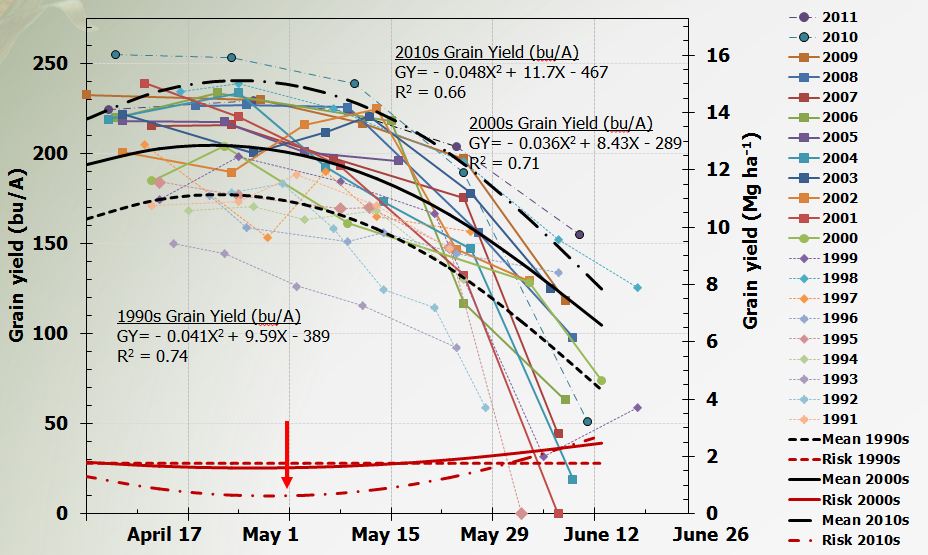| April 2, 2012 |
Field Crops 28.421 - 93 |
Patience When Thinking about
Planting Corn this Year
Joe Lauer, Corn Agronomist
The weather this year has many farmers and agronomists wondering, "What
if?" What if I had planted in March? What if I plant before crop insurance
kicks in on April 11? What if I wait until "normal" planting dates?
Every year we recommend, when planting prior to April 20, that field
conditions must dictate when we start planting. This year field
conditions were right in March. The historical optimum planting date
for corn is May 1 in southern Wisconsin and May 7 in northern.
Every field and farm likely has slightly different optimum planting
dates. We also know that delayed planting often results in lower
yields as well as the "double-whammy" of higher grain moisture,
which can be as expensive as lower yields.
Since 1991, we have conducted a planting date trial every year at
the UW Agricultural Research Center in Arlington. We target May 1 as
the optimum planting date and we plant as early as field conditions
allow before that date and every two weeks after (May 15, June 1,
and June 15). Often when we plant corn on the first date, there is
still snow on the sides of the fields in ditches.
Figure 1 shows the grain yield response to planting date and the
risk associated with each planting date of a full-season hybrid at
Arlington. The heavy lines are the averages that have occurred
during the 1990s, 2000s and 2010s (so far). Both 2010 and 2011 were
exceptionally high yielding years. In each decade we have seen an
increase in grain yield. The planting date response pattern is
similar between decades. The optimum planting date has been around
May 1. All April planting dates were greater than 95% of the optimum
date. It isn't until mid-May that yields fall below 95% of the
optimum planting date. During 1995 and 2001 no grain yield was produced on the last
planting dates in June.

Figure 1. The corn grain yield response of planting date at
Arlington, WI. Grain yield risk is the standard deviation (+
bu/A) associated with each planting date. The arrow is the
historical optimum planting date.
During the 1990s, planting date risk (or the standard deviation) was
the same (+ 28 bu/A) regardless of planting date. During the 2000s, risk was
curvilinear with higher risk during later planting dates. So far in
the 2010s, planting date risk is also curvilinear with the least
risk occurring on the historical optimum planting date of May 1.
The earliest we have ever planted corn at Arlington was during 2010
in a trial designed to test the effect of seed treatments on early
season stress (see
report
here). In that trial we planted March 31, April 14, and May
18. This was not a planting date trial since treatments were planted
in side-by-side blocks by planting date, but it gives us some sense of what might
happen with March planting. The average yield for each respective planting date among all of the treatments was 227, 238 and 227 bu/A.
Insurance coverage needs to be considered when
thinking about when to start planting corn. For the latest on crop
insurance see Mitchell (2012).
When planting early we are most concerned about the
last spring killing
frost. This has to occur before the growing point moves
above ground after the V5 developmental growth stage (Abendroth et
al., 2011). We don't have to go too far back to remember the
devastating effects of a late-killing frost that occurred on June
20, 1992 when most of the Wisconsin crop was between V6 and V8.
Unfortunately, the last killing frost is difficult to predict and
manage for.
Of course replanting can occur for numerous reasons besides
late-killing frost.
The biggest concern in a replant situation is hybrid choice
of the replanted hybrid. Can I replace the hybrid I chose? If I have to settle for
another hybrid, what is the yield penalty of the alternative hybrid?
What is the yield penalty of the later planting date? What about the
"double whammy" of lower yield AND higher grain moisture?
Patience is key here. You only get one chance to do things right in
a field. Be ready to go. Get as much of your spring work done as you
can. Waiting until the crop insurance dates kick in is not
unreasonable.
Literature Cited
Abendroth, L.J., R.W. Elmore, M.J. Boyer, and S.K. Marlay. 2011.
Corn growth and development. PMR1009. Iowa State University.
Mitchell, P. 2012. Crop Insurance Implications of Planting Crops
Early. Wisconsin Crop Manager, March 21, 2012
http://ipcm.wisc.edu/blog/2012/03/960/.